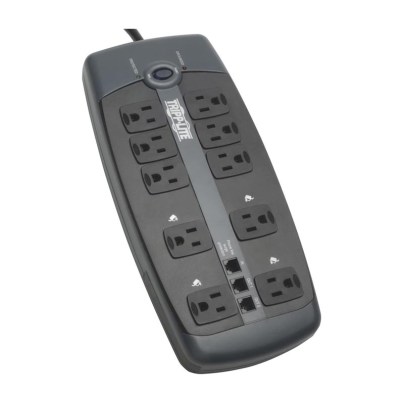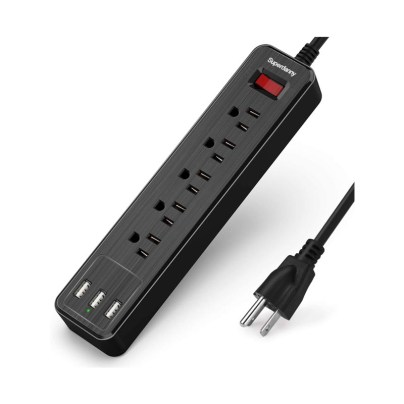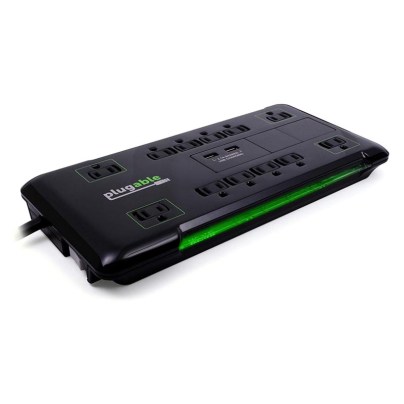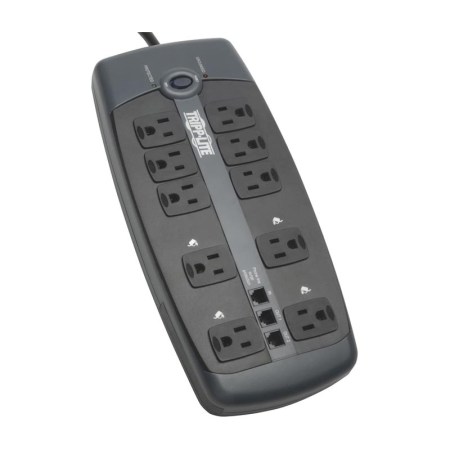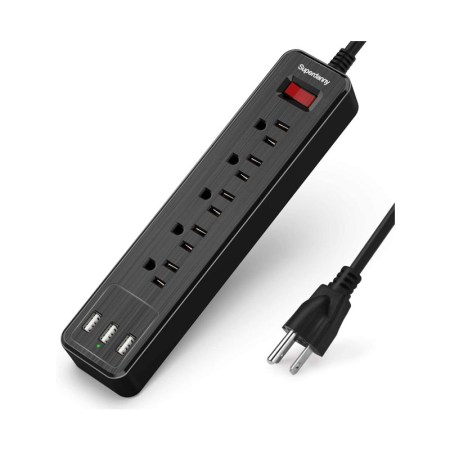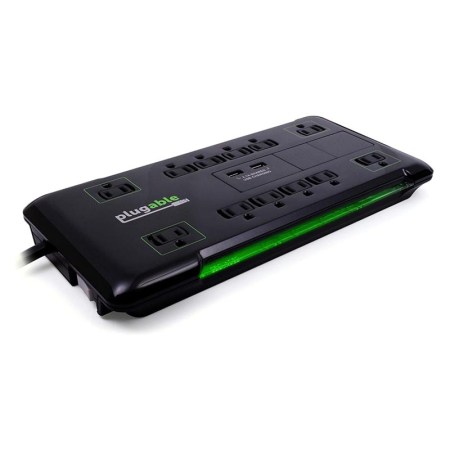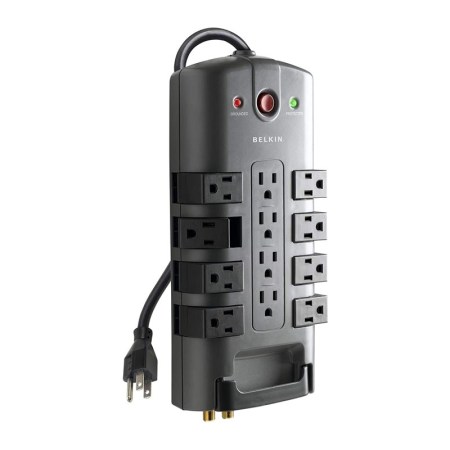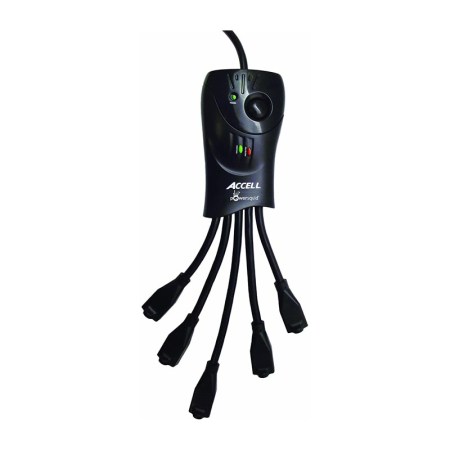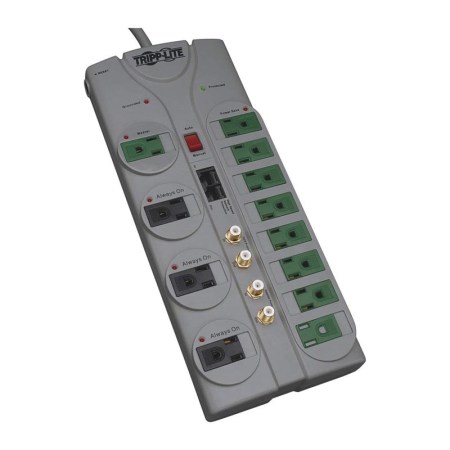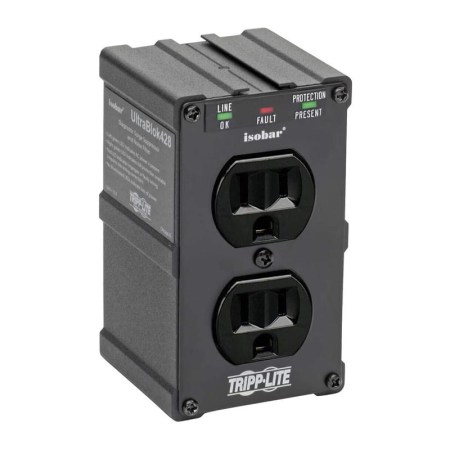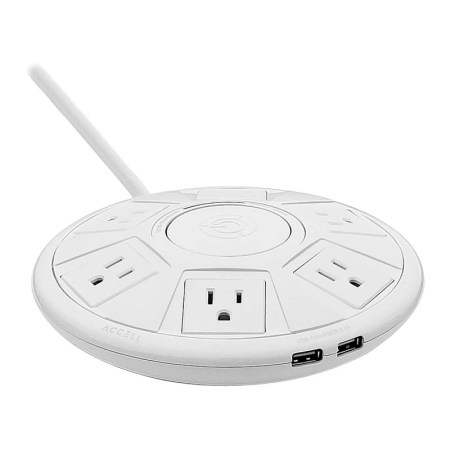We may earn revenue from the products available on this page and participate in affiliate programs. Learn More ›
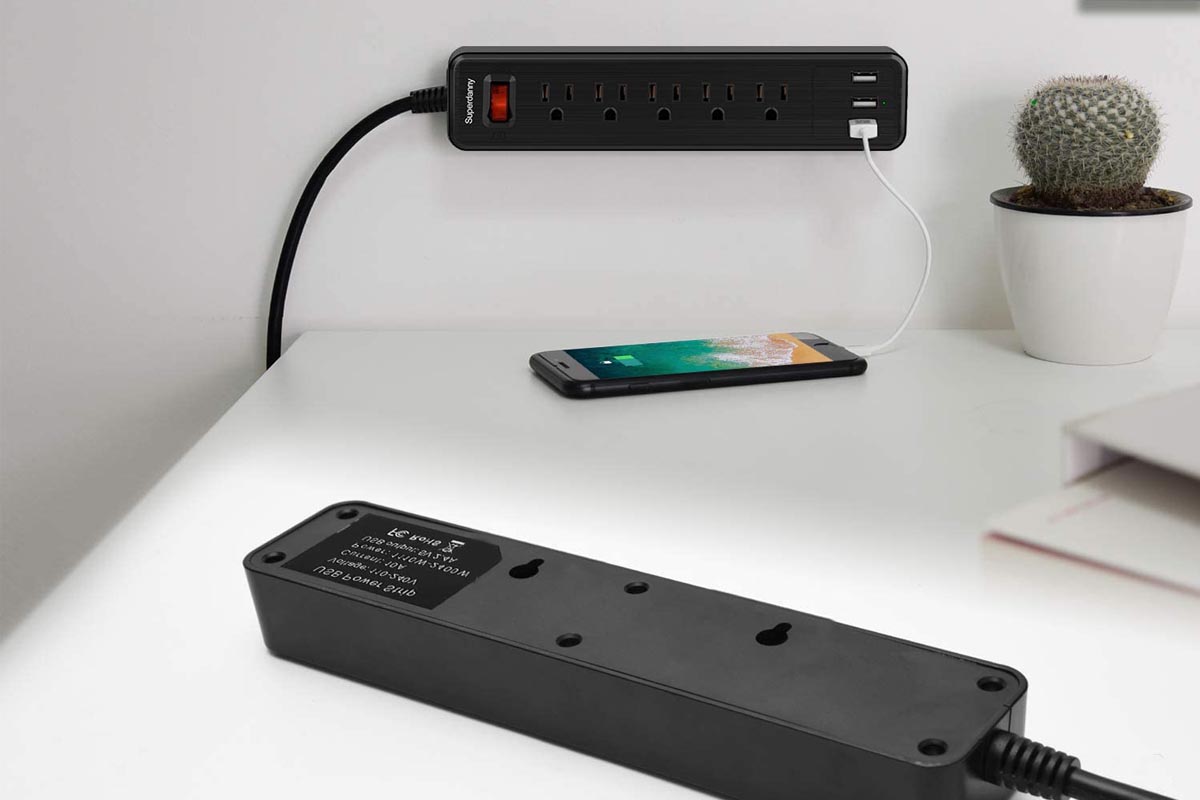
If you’ve spotted flickering lights, tripped circuits, or prolonged overheating of any of the electronic devices in your home, your home may have experienced a power surge. This is a sudden, brief jump in voltage (lasting as few as 3 nanoseconds) above the standard 120 volts that runs through the home. It might be caused by switching on a high-voltage electronic device, improper wiring, an overtaxed power grid, or even wind or rain, any of which can lead to equipment failure or electrical fire.
Luckily, a set of surge protectors can save the day in a home office, entertainment center, or wherever big-ticket electronics live. Resembling power strips, these devices plug into a grounded wall outlet (a three-prong outlet) and offer a number of spots to plug in. But, unlike power strips, which don’t protect electronics from voltage spikes, surge protectors divert voltage above a certain threshold to the ground wire. Should the house experience a surge, these devices stave off damage to computers, printers, gaming systems, and other electrical appliances.
The best surge protector is one that works as advertised during a real power surge. To narrow your options, keep reading for the ideal specs to look for in a surge protector and recommendations for some of the best surge protectors on the market.
- BEST OVERALL: Tripp Lite TLP1008TEL 10 Outlet Surge Protector
- BEST BANG FOR THE BUCK: SUPERDANNY USB Surge Protector Power Strip
- UPGRADE PICK: Plugable Surge Protector Power Strip With USB
- BEST FOR SENSITIVE TECH: Belkin 12-Outlet Pivot-Plug Surge Protector
- BEST FOR LARGE ADAPTERS: Accell Powersquid Flexible Surge Protector
- BEST ENERGY-SAVING: Tripp Lite 12 Outlet Surge Protector Power Strip
- BEST FOR TRAVEL: Tripp Lite Isobar Surge Protector Power Strip
- BEST WITH USB PORTS: Accell Power Air
What to Look for When Buying the Best Surge Protector
While considering whether to spend a few dollars or up to the triple digits, just remember: Protectors on the higher end of this range help protect expensive electronic devices that would be costly to replace if damaged by a power surge. Price tag, however, shouldn’t be the only guiding factor in the buying decision. When shopping, look for these key criteria to determine which options are the best surge protectors.
UL Rating
Look for both the UL mark (a symbol consisting of a circle inscribed with “UL”) and a specific rating of “UL Listed,” or, even better, “UL 1449 Listed” or “UL 1449 Revision 2.” These marks indicate that the surge protector has undergone rigorous safety and performance testing by the Underwriters Laboratory and meets the minimum performance rating for surge protectors. Surge protectors without this mark or with only the label “UL” or “UL tested” offer insufficient surge protection capabilities.
Clamping Voltage
This term refers to the voltage level at which the surge protector begins to attenuate or reduce the surge—the lower the better. The best surge protectors feature a clamping voltage of no more than 400 volts.
Joule Rating
This rating indicates the amount of energy that the surge protector can absorb before failing. Look for a joule rating of at least 360 joules. For expensive or sensitive electronics, such as computers, recording equipment, or hard drives, raise the standard and search for a joule rating of at least 1,000 joules.
Number of Outlets
Shop for a surge protector with enough outlets (including plug and/or USB ports) to accommodate all the devices you plan to plug into it—a minimum of five is recommended. (Per Pew Research, the typical median number of connected devices in a household is five or six, depending on the age of the household members.)
Status Indicators
At a minimum, look for surge protectors with LED lights that indicate whether the devices plugged into the surge protector are currently protected. Some products contain additional diagnostics LEDs that help diagnose power problems.
Energy-Saving Features
While not a must-have, a surge protector with energy-saving features, such as an automatic outlet shutoff, can reduce the home’s energy consumption and overall energy bills.
Our Top Picks
To help narrow the search, this guide showcases some of the best surge protectors on the market based on all these criteria. Here are nine top-notch options to choose from.
Best Overall
Tripp Lite TLP1008TEL 10 Outlet Surge Protector
See ItThis UL-1449-Listed Tripp Lite TLP1008TEL Surge Protector Strip features 10 plug outlets, a clamping voltage of 150 volts, and up to 2,395 joules of surge suppression. If surge protection becomes compromised, a built-in resettable 15-amp circuit breaker automatically shuts off power to the outlets and saves electronics. The illuminated master switch provides the ability to turn on and off the connected devices with a single touch, while green and red status LED lights indicate protection status and grounded status, respectively.
Best Bang for the Buck
SUPERDANNY USB Surge Protector Power Strip
See ItThrifty tech enthusiasts can defend their laptop, phone, and up to six other essential electronic devices against voltage jumps and excessive heat with SUPERDANNY’s USB fire-sale, fire-retardant surge protector. It includes five outlets and three USB ports. The UL-listed device starts to reduce surges at a clamping voltage of 300 volts and absorbs up to 900 joules, with an amber indicator light to signal that devices are safe from surges.
Use the mounting holes on the back to install the surge protector on the wall for easy access. It also features a 4.5-foot power cord.
Upgrade Pick
Plugable Surge Protector Power Strip With USB
See ItThis Plugable Surge Protector Power Strip provides a whopping 4,320 joules of protection and operates at a high clamp voltage of 330 volts. The UL-1449-Listed, 12-outlet power bar works well with those monster collections of diverse electronics and cables.
Two USB ports in the center power phones and other diminutive devices, while the four larger AC outlets strategically placed at a distance from the eight main outlets make room for large brick adapters. A bright green indicator light indicates that the devices are protected.
Best for Sensitive Tech
Belkin 12-Outlet Pivot-Plug Surge Protector
See ItThis UL-1449-Listed 12-Outlet Pivot-Plug Power Strip from Belkin features a clamping voltage of 330 volts that can absorb up to 4,320 joules of surge, yet keep the power on even after surge protection has been compromised. This is an advantage for those who own many sensitive devices that can be damaged with abrupt shutdowns, such as a solid-state storage device. The ergonomic design fits two LED status indicators (“Protected” and “Not Grounded) next to four stationary vertical and eight pivoting right-angle plug outlets that can accommodate—and monitor—both small and larger adapters. Three bonus RJ11 jacks afford surge protection for telephone and fax equipment as well.
Best for Large Adapters
Accell Powersquid Flexible Surge Protector
See ItEach of the five squid-like arms of this UL-1449-Rated Accell Powersquid Flexible Surge Protector features a sizable plug socket that bends back and forth or side to side to power unwieldy transformers and large adaptors. Their flexible construction also means that they move in the direction of any arms that accidentally get pulled, so users are less likely to unintentionally cut power to the electronics by tripping over a cord. With a clamping voltage of 400 volts, the device stops conducting power after it reaches a maximum absorption capacity of 1,080 joules.
Best Energy-Saving
Tripp Lite 12 Outlet Surge Protector Power Strip
See ItThis UL-1449-Listed Tripp Lite energy-efficient device not only protects, but also helps lower electric bills. Out of its dozen outlets, one is a master outlet; three outlets always stay powered on; and eight are energy-saving outlets that shut off when the device detects the user has powered off the equipment connected to the master outlet. Essentially, it counteracts the “vampire” effect of low energy use by powered-down appliances that happen to be plugged into outlets. All outlets get an added boost of safety from diagnostic LEDs and integrated child-safe sliding outlets that can be shut when the outlets are inactive. This Tripp Lite surge protector features a 3,600-joule capacity and a clamping voltage of 150 volts.
Best for Travel
Tripp Lite Isobar Surge Protector Power Strip
See ItMeasuring just 4 inches tall and 2 1/2 inches wide, the two-outlet Tripp Lite Surge Protector weighs less than a pound, which means tech-loving travelers who pack lightly have space for it. Its small size belies its powerful surge suppression: It can absorb up to 1,410 joules of energy, starting at a clamping voltage of just 140 volts. A green indicator light signals that the device is protected. The device was built to the UL 1449 3rd-edition standard, ensuring the highest level of safety.
Best with USB Ports
Accell Power Air
See ItWhether listening to tunes or participating in a conference call, this USB Power Air from Accell keeps users connected with six adapter-friendly outlets plus two side-by-side USB ports. Its blue LED indicates the plugged-in devices are safe from sudden spikes in voltage.
The UL-listed surge protector’s 400-volt clamp rating and 1,080-joule absorption capacity can help keep circuits from tripping needlessly, while the round, scratch-resistant base and 6-foot power cord make it easy to stay connected.
The Advantages of Owning a Surge Protector
Though they often go unnoticed, electrical surges can occur many times a day in an average home. Each surge has the potential to damage the circuitry of plugged-in devices and cause them to stop operating, damage the circuitry in other parts of the home, or even cause fires.
Moreover, surge protectors are relatively affordable: An investment of $15 to $100 for an average surge protector can help avoid hundreds, or even thousands, in device repair or replacement costs. Since many can double as power strips, one product can supply reliable power.
While reducing surges, they also allow plugged-in devices to remain operational, resulting in fewer disruptions. Surge protectors:
- Increase the useful life of the devices and the safety of the home.
- Are quite affordable, multi-purpose, and save on device repair or replacement costs in the long term.
- Prevent disruptions in the daily use of electronics.
FAQs About Your New Surge Protector
After reading this guide, you still may have questions about selecting the best surge protector or using it safely. Find some of the most frequently asked questions about buying and using a new surge protector below.
Q. How do surge protectors work?
When the voltage from an outlet surges or rises above a certain threshold, known as the “clamping voltage,” a surge protector diverts excess current above that threshold to a ground wire that extends into the ground beneath the home, preventing damage to the devices plugged into the protector, but keeping them still powered and operational.
Q. How many joules does a good surge protector have?
A rating of at least 360 joules is desirable, but the higher the rating, the better. For expensive or surge-sensitive electronics (e.g., hard drives), look for at least 1,000 joules.
Q. How do I choose a surge protector?
Beyond an adequate joule rating, look for a device labeled “UL Listed,” with a clamping voltage of no more than 400 volts and a status indicator to let you know the devices are protected. The number of outlets should match the number of devices that need protection. The average user needs at least five. Energy-saving features like automatic outlet shutoff are nice to have, but not a must.
Q. What can you not plug into a surge protector?
To avoid circuit overloads and fires, don’t plug in medical equipment, refrigerators, space heaters, or other devices with a motor unless the surge protector is labeled for use with that type of equipment. Never plug a surge protector or power strip into another surge protector.
